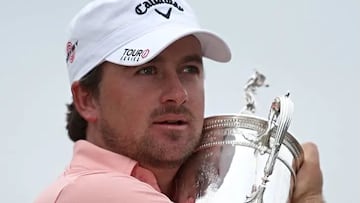Graeme McDowell violated LIV’s anti-doping policy: Does the PGA Tour have a list of banned substances?
McDowell has been fined $125,000 and suspended by LIV Golf for one tournament for violating anti-doping rules. The PGA Anti-Doping Program is quite explicit about which substances are prohibited and the rules on testing players.

Graeme McDowell has been suspended by LIV Golf and hit with a $125,000 fine for breaking the circuit’s strict anti-doping rules.
A statement said: “LIV Golf has suspended Smash GC’s Graeme McDowell for one tournament after determining he violated the league’s anti-doping policy during LIV Golf Nashville by using a decongestant medicine that included a banned substance, R-methamphetamine (levo-methamphetamine). Accordingly, and in accordance with the Policy, a one tournament suspension effective at LIV Golf Greenbrier will be imposed; a fine of $125,000 will be assessed; and the player’s and team’s results for LIV Golf Nashville will be disqualified (with prize money and points retroactively adjusted).”
The Northern Irishman will miss the next event in the series, The Old White in West Virginia which gets underway on 16 August. After serving the duration of his ban, he will be able to return for the Chicago tournament at Bolingbrook Golf Club on 13 September.
McDowell apologies for using banned substance
McDowell gave his side of the story, pleading innocence in a statement: “Ahead of LIV Nashville, I was struggling with severe congestion that was affecting my sleep. In an effort to manage it, I used a generic nasal decongestant without realising it might be on the banned list. As a professional golfer, I understand the importance of checking all medications and the option to apply for a Therapeutic Use Exemption (TUE). Unfortunately, I did not think to do this due to the over-the-counter nature of this medicine and I deeply regret the oversight. I fully accept the sanctions imposed by LIV.”
— Graeme McDowell (@Graeme_McDowell) August 11, 2024
Covert doping widespread in all areas of sport
In any professional sport you are going to find cases of covert doping. Earlier this year, cyclist Jan Ullrich got his doping confession off his chest, telling Stern “I doped. I came into contact with it in 1995, 1996, before the Tour de France. I was young and naive and came into an existing system. The general attitude was: how are you going to survive in a race if you don’t take it?”
The practice even extends to perceptively less strenuous activities like golf. Eyebrows were raised at Bryson DeChambeau’s striking physical transformation at the 2020 US Open. Looking decidedly brawnier, DeChambeau gained 9 kg of muscle mass in three months and claimed it was down to a high protein diet which consisted of consuming 3,000-3,500 calories per day.
Golf Hall of Fame member Vijay Singh admitted using Deer Antler velvet extract spray, which contains an anabolic insulin-like growth factor 1 (IGF-1) which was then a banned substance on Wada’s prohibited list. He was later cleared.
PGA Tour’s anti-doping program banned substances
Anabolic Androgenic Steroids (AAS)
- 1-Androstenediol (5a-androst-1-ene-3ß,17ß-diol
- 1-Androstenedione (5a-androst-1-ene-3,17-dione)
- 1-Testosterone (17ß-hydroxy-5a-androst-1-en-3-one)
- 4-Hydroxytestosterone (4,17ßdihydroxyandrost-4-en-3-one)
- Bolandiol (estr-4-ene-3ß,17ß-diol)
- Bolasterone
- Calusterone
- Clostebol
- Danazol ([1,2]oxazolo[4’,5’:2,3]pregna-4-en-20-yn-17a-ol)
- Dehydrochlormethyltestosterone (4-chloro-17ß-hydroxy17a-methylandrosta-1,4-dien-3 one)
- Desoxymethyltestosterone (17a-methyl-5a-androst-2-en-17ß-ol)
- Drostanolone
- Ethylestrenol (19-norpregna-4-en-17a-ol)
- Fluoxymesterone
- Formebolone
- Furazabol (17a-methyl [1,2,5]oxadiazolo[3’,4’:2,3]-5a-androstan-17ß-ol)
- Gestrinone; Mestanolone; Mesterolone; Metandienone (17ß-hydroxy-17a-methylandrosta-1,4-dien3 one)
- Metenolone
- Methandriol
- Methasterone (17ß-hydroxy-2a,17adimethyl-5a-androstan-3-one)
- Methyldienolone (17ß-hydroxy-17a-methylestra-4,9-dien3-one)
- Methyl-1-testosterone (17ß-hydroxy-17a-methyl-5a-androst-1-en-3-one)
- Methylnortestosterone (17ß-hydroxy-17a-methylestr-4-en3-one)
- Methyltestosterone; Metribolone (methyltrienolone, 17ß-hydroxy-17a-methylestra-4,9,11-trien-3 one)
- Mibolerone
- Norboletone
- Norclostebol
- Norethandrolone
- Oxabolone
- Oxandrolone
- Oxymesterone
- Oxymetholone
- Prostanozol (17ß-[(tetrahydropyran-2-yl)oxy]-1’Hpyrazolo[3,4:2,3]-5a-androstane)
- Quinbolone
- Stanozolol
- Stenbolone
- Tetrahydrogestrinone (17-hydroxy-18a-homo-19-nor-17a-pregna-4,9,11-trien-3-one)
- Trenbolone (17ß-hydroxyestr-4,9,11-trien-3-one); and other substances with a similar chemical structure or similar biological effect(s).
PGA Tour’s anti-doping program banned substances
Exogenous Anabolic Androgenic Steroids (AAS)
- 19-Norandrostenediol (estr-4-ene-3,17-diol)
- 19-Norandrostenedione (estr-4-ene-3,17-dione)
- Androstenediol (androst-5-ene-3ß,17ß-diol)
- Androstenedione (androst-4-ene-3,17-dione)
- Boldenone; Boldione (androsta-1,4-diene-3,17-dione)
- Dihydrotestosterone (17ß-hydroxy-5a-androstan-3-one)
- Nandrolone (19-nortestosterone)
- Prasterone (dehydroepiandrosterone, DHEA, 3ß-hydroxyandrost-5-en-17-one)
- Testosterone and their metabolites and isomers, including but not limited to:
3ß-Hydroxy-5a-androstan-17-one - 5a-Androst-2-ene-17-one
- 5a-Androstane-3a,17a-diol
- 5a-Androstane-3a,17ß-diol
- 5a-Androstane-3ß,17a-diol
- 5a-Androstane-3ß,17ß-diol
- 5ß-Androstane-3a,17ß-diol
- 7a-Hydroxy-DHEA; 7ß-Hydroxy-DHEA
- 4-Androstenediol (androst-4-ene-3ß, 17ß-diol)
- 5-Androstenedione (androst-5-ene-3,17-dione)
- 7-Keto-DHEA
- 19-Norandrosterone
- 19-Noretiocholanolone
- Androst-4-ene-3a,17a-diol
- Androst-4-ene-3a,17ß-diol
- Androst-4-ene-3ß,17a-diol
- Androst-5-ene-3a,17a-diol
- Androst-5-ene-3a,17ß-diol
- Androst-5-ene-3ß,17a-diol
- Androsterone
- Epi-dihydrotestosterone
- Epitestosterone
- Etiocholanolone.
Jan Ullrich spricht im aktuellen Stern über seine Abstürze. Das Exklusivinterview: https://t.co/SPpdL7YlZ1 #janullrich pic.twitter.com/otvZiJDVz3
— stern (@sternde) November 21, 2023
In 2016, Rory McIlroy highlighted how easy it is to find a way around the PGA Tour’s anti-doping controls: “I could use HGH (human growth hormone) and get away with it. So I think blood testing is something that needs to happen in golf just to make sure that it is a clean sport going forward.”.
The Anti-Doping Program was established in 2008 - nine years after the World Anti-Doping Agency (WADA) came into existence, in order “to protect the integrity that is inherent in the sport of golf and to ensure the health and safety of all players”.
PGA Tour’s anti-doping program banned substances
Peptide Hormones, Growth Factor, Related Substances and Mimetics
- Erythropoietin-Receptor agonists:
- Erythropoiesis-Stimulating Agents (ESAs) including e.g. Darbepoietin (dEPO)
- Erythropoietins (EPO)
- EPO-Fc
- EPO-mimetic peptides (EMP), e.g. CNTO 530 and peginesatide; GATA inhibitors, e.g. K-11706; Methoxy polyethylene glycol-epoetin beta (CERA); Transforming Growth Factor-ß (TGF-ß) inhibitors, e.g. sotatercept, luspatercept
- Non-erythropoietic EPO-Receptor agonists, e.g. ARA-290; Asialo EPO Carbamylated EPO.
- Hypoxia-inducible factor (HIF) stabilizers, e.g. cobalt, molidustat and roxadustat (FG-4592) and HIF activators, e.g. argon and xenon.
- Chorionic Gonadotrophin (CG) and Luteinizing Hormone (LH) and their releasing factors, e.g. buserelin, gonadorelin and leuprorelin, in males.
- Corticotrophins and their releasing factors, e.g. corticorelin.
- Growth Hormone (GH) and its releasing factors including: Growth Hormone Releasing Hormone
(GHRH) and its analogues, e.g. CJC-1295, sermorelin and tesamorelin - Growth Hormone Secretagogues (GHS), e.g. ghrelin and ghrelin mimetics, e.g. anamorelin and ipamorelin; GHReleasing Peptides (GHRPs), e.g. alexamorelin, GHRP-6, hexarelin, and pralmorelin (GHRP-2).
Additional prohibited growth factors:
- Fibroblast Growth Factors (FGFs)
- Hepatocyte Growth Factor (HGF)
- Insulin-like Growth Factor-1 (IGF1) and its analogues
- Mechano Growth Factors (MGFs)
- Platelet-Derived Growth Factor (PDGF)
- Vascular-Endothelial Growth Factor (VEGF) and any other growth factor affecting muscle, tendon or ligament protein synthesis/degradation, vascularisation, energy utilization, regenerative capacity, or fibre type switching.
PGA Tour’s anti-doping program banned substances
Hormone and Metabolic Modulators
- Aromatase inhibitors including, but not limited to: 4-Androstene-3,6,17 trione (6-oxo)
- Aminoglutethimide
- Anastrozole
- Androsta-1,4,6-triene-3,17-dione (androstatrienedione)
- Androsta-3,5-diene-7,17-dione (arimistane)
- Exemestane
- Formestane
- Letrozole
- Testolactone
- Selective estrogen receptor modulators (SERMs)
- Raloxifene
- Tamoxifen
- Toremifene
- Clomiphene
- Cyclofenil
- Fulvestrant
- myostatin inhibitors
- Activators of the AMP-activated protein kinase (AMPK), e.g. AICAR; and Peroxisome Proliferator Activated Receptor δ (PPARd) agonists, e.g. GW 1516
How does the PSG Tour test players for banned substances?
All players who take part in a PGA Tour event may be required to undergo a doping control in which urine and blood samples are taken and tested. The tests are conducted by Drug Free Sport on behalf of the PGA Tour. Players may be selected for testing at any time or place, both inside and outside of tournament competition. Players do not receive prior warning that they will be summoned to take a test.
Office of the Commissioner statement regarding Byeong Hun An pic.twitter.com/TVAxkPxg5k
— PGA TOUR Communications (@PGATOURComms) October 11, 2023
Samples analyzed by labs are identified by code numbers and not players’ names. If the sample is negative for a prohibited substance, the player will usually receive notification within three weeks from the Program Administrator.
If the sample tests positive, the Program Administrator will conduct an initial review to determine whether the player has an approved Therapeutic Use Exemption (TUE) for the particular substance found in the sample. If the initial review supports the finding of a potential violation, players may be required to provide further samples.
Related stories
Players may obtain a TUE for the use of a prohibited substance as long as it does not produce any additional enhancement of performance. However, prior to a TUE being granted, a player who uses a substance on the PGA Tour Prohibited List runs the risk of being denied a TUE.
Eight players have been suspended since the PGA Tour launched its anti-doping program in 2008 - the most recent being Byeong Hun An who was hit with a three-month ban in October last year after a doping control detected a banned substance found in cough medicine sold over the counter in South Korea.


Complete your personal details to comment